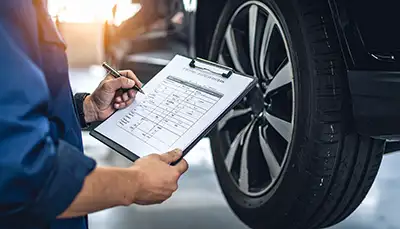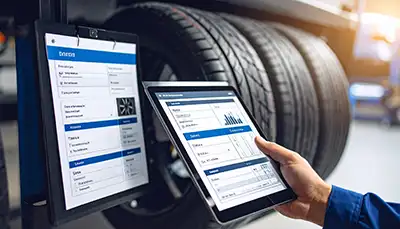Understanding Wheel & Tire Fitment
Proper wheel and tire fitment is essential for your vehicle's performance, safety, and appearance. When wheels and tires are correctly matched to your vehicle, you'll experience optimal handling, braking, and ride quality. Incorrect fitment can lead to rubbing, premature wear, poor handling, and even safety hazards. This comprehensive guide will walk you through everything you need to know to ensure perfect fitment for your specific vehicle.
Wheel Fitment Fundamentals
Before diving into specifics, it's important to understand the key measurements and terms related to wheel fitment:
Wheel Diameter
This is the most obvious wheel measurement, typically ranging from 15 to 24+ inches for passenger vehicles. Your wheel diameter should be compatible with your vehicle's brake system and suspension design. Most vehicles can accommodate wheels that are 1-2 inches larger than the original equipment (OE) size, but larger changes may require additional modifications.
Wheel Width
Measured from bead seat to bead seat (not the outer edges), wheel width affects how your tire sits on the wheel and how your vehicle handles. Wider wheels generally provide better cornering stability but may require specific tire sizes to maintain proper fitment. Width is typically measured in inches or millimeters.
Bolt Pattern
Also called bolt circle or pitch circle diameter (PCD), this measurement indicates how many lug nuts secure your wheel and the diameter of the circle they form. For example, a 5x114.3 bolt pattern means 5 lugs on a circle with a diameter of 114.3mm. This measurement must match your vehicle exactly, as adapters can compromise safety.
Center Bore
This is the hole in the center of the wheel that centers it on the hub of your vehicle. A perfect match (hub-centric) provides the most accurate centering and reduces vibration. Hub-centric rings can be used if the wheel's center bore is larger than your vehicle's hub.
Offset
Perhaps the most critical and often misunderstood measurement, offset is the distance from the wheel's mounting surface to the centerline of the wheel, measured in millimeters:
- Positive offset: The mounting surface is toward the front or outside face of the wheel. Most front-wheel-drive vehicles have positive offset wheels.
- Zero offset: The mounting surface is even with the centerline of the wheel.
- Negative offset: The mounting surface is toward the back or brake side of the wheel. This creates a "deep dish" appearance and is common on many trucks and SUVs.
Offset affects how the wheel sits in the wheel well and its relationship to suspension components. Incorrect offset can cause rubbing, poor handling, and increased stress on bearings and suspension parts.

Backspacing
Closely related to offset, backspacing is the distance from the mounting surface to the inner edge of the wheel. This measurement helps determine if the wheel will clear suspension components, brake calipers, and the inner fender well. Backspacing is particularly important for lifted trucks and off-road vehicles.
Tire Fitment Essentials
Once you understand wheel fitment, you need to match appropriate tires to those wheels:
Tire Size Nomenclature
Tire sizes use a standardized format. For example, in P245/45R18:
- P: Type of tire (P for passenger, LT for light truck)
- 245: Section width in millimeters
- 45: Aspect ratio (sidewall height as a percentage of section width)
- R: Construction (R for radial, the most common type)
- 18: Wheel diameter in inches
Tire Width Compatibility
Each wheel width has a range of compatible tire widths. A good rule of thumb is that the tire's section width in millimeters, when divided by 25.4 (to convert to inches), should be approximately 20-30% wider than the wheel width. For example, a 7-inch wide wheel would work well with tires around 205mm to 225mm wide.
Aspect Ratio Considerations
When changing wheel diameters, you'll need to adjust the tire's aspect ratio to maintain a similar overall diameter. This helps preserve your speedometer and odometer accuracy, ground clearance, and gear ratio effectiveness. A lower aspect ratio (lower profile) tire provides better handling but a firmer ride, while a higher aspect ratio offers better ride comfort and impact absorption.
Load Rating & Speed Rating
Always match or exceed your vehicle's required load and speed ratings. The load index indicates how much weight each tire can support, while the speed rating tells you the maximum sustained speed capability. These ratings are found after the size designation (e.g., 95V, where 95 is the load index and V is the speed rating).
Vehicle-Specific Fitment Factors
Passenger Cars
Most passenger cars can safely accommodate wheels 1-2 inches larger than OE size with appropriate offset and tire size adjustments. Front-wheel-drive vehicles typically require positive offset wheels (ET30 to ET45) to clear strut assemblies. When upsizing, reducing the tire's aspect ratio is necessary to maintain proper overall diameter.
SUVs & Crossovers
These vehicles often have more wheel well clearance, allowing for more flexibility in wheel and tire sizing. However, larger, heavier wheels can affect fuel economy and acceleration. For improved off-road performance, some owners opt for smaller diameter wheels with larger sidewall tires for better traction and impact absorption.
Trucks & Off-Road Vehicles
Pickup trucks and dedicated off-road vehicles often use wheels with lower positive or even negative offset to increase track width for stability. Backspacing becomes particularly important with lifted vehicles or when installing larger tires. Always consider fender clearance, turning radius limitations, and potential rubbing points when significantly altering wheel and tire sizes.
Performance Vehicles
Performance-oriented vehicles benefit from wider wheels and lower profile tires for improved cornering and braking. However, extreme changes can negatively impact ride quality and may require suspension modifications. Always ensure that performance wheels maintain adequate clearance for large brake calipers commonly found on these vehicles.
Fitment Problem-Solving
Rubbing Issues
If your wheels or tires rub against suspension components or body panels:
- Adjust wheel offset to move the assembly inward or outward
- Use a smaller tire width or lower profile
- Install fender flares or perform minor fender rolling
- Consider a mild suspension lift or leveling kit
Poke or Tuck
"Poke" refers to wheels extending beyond the fender, while "tuck" means they sit inside the wheel well. Local regulations often restrict extreme poke for safety reasons. The ideal setup typically has the tire sidewall aligned closely with the fender edge for a clean look and optimal performance.
Brake Caliper Clearance
Larger brake systems may require specific wheel designs with adequate spoke clearance. Most wheel manufacturers provide brake caliper clearance specifications or can perform a test fit. Wheel spacers should be used cautiously and only when necessary, as they affect the vehicle's suspension geometry.
Using Fitment Tools
To take the guesswork out of fitment, we recommend using specialized tools:
- Vehicle-specific fitment guides: These databases match wheels and tires to specific vehicle makes and models based on manufacturer specifications and real-world testing.
- Tire size calculators: Calculate the effective diameter, circumference, and sidewall height when changing tire sizes to maintain proper speedometer readings.
- Offset calculators: Visualize how different offsets will position your wheels relative to suspension components and fenders.
- Professional consultation: Our fitment specialists can provide personalized recommendations based on your vehicle and performance goals.

Key Takeaways: Wheel & Tire Fitment
- Wheel offset and backspacing are critical measurements that affect clearance, handling, and appearance.
- Bolt pattern must match your vehicle exactly for safety and proper installation.
- Tire width should be proportional to wheel width for optimal performance and wear.
- When changing wheel diameter, adjust tire aspect ratio to maintain similar overall diameter.
- Different vehicle types have different fitment considerations and limitations.
- Use vehicle-specific fitment guides and calculators to ensure compatibility.
- Load and speed ratings should always meet or exceed your vehicle manufacturer's specifications.
FAQ: Wheel & Tire Fitment
How do I find my vehicle's correct wheel specifications?
You can find your vehicle's original equipment (OE) wheel and tire specifications in several places: your owner's manual, the driver's side door jamb sticker, the fuel door, or by contacting your dealer with your VIN. For the most accurate aftermarket fitment information, we recommend using our vehicle-specific fitment guide that accounts for brake caliper clearance and suspension component interference.
What happens if I use wheels with the wrong offset?
Incorrect offset can cause numerous issues: too positive an offset may cause inner clearance problems with suspension components, while too negative an offset can lead to rubbing against fenders, reduced turning radius, and increased stress on wheel bearings and suspension. Even when a wheel physically fits, improper offset can negatively affect handling, braking stability, and accelerate component wear.
Can I put wider tires on my stock wheels?
Each wheel width has a range of compatible tire widths. Generally, you can go slightly wider than your OE tire size on stock wheels, but extreme changes can cause handling issues and uneven wear. A general guideline is that the tire's section width in millimeters divided by 25.4 should be approximately 20-30% wider than the wheel width in inches. Always consult a tire specialist before making significant changes.
Do I need wheel spacers for my aftermarket wheels?
Quality aftermarket wheels should be designed with the correct offset to fit without spacers. Spacers should only be used as a last resort when minor clearance adjustments are needed. When used, only high-quality, hub-centric spacers should be considered, and lug nuts should be torqued to specification and checked regularly. Keep in mind that spacers effectively change your wheel's offset and can affect handling characteristics.
How much can I upsize my wheels without problems?
Most vehicles can safely accommodate wheels 1-2 inches larger than OE diameter with appropriate tire size adjustments. Beyond that, you may need suspension modifications, fender alterations, or other changes to prevent rubbing and ensure proper performance. When upsizing, it's important to maintain a similar overall diameter by reducing the tire's aspect ratio proportionally to keep speedometer accuracy and preserve proper mechanical advantage.
What's the difference between hub-centric and lug-centric wheels?
Hub-centric wheels center on your vehicle's hub for the most accurate fitment and reduced vibration. The wheel's center bore exactly matches your vehicle's hub diameter. Lug-centric wheels rely on the lug nuts to center the wheel, which can lead to minor vibrations and puts more stress on the lugs. For aftermarket wheels with larger center bores, hub-centric rings can be used to convert them to hub-centric fitment for better performance.